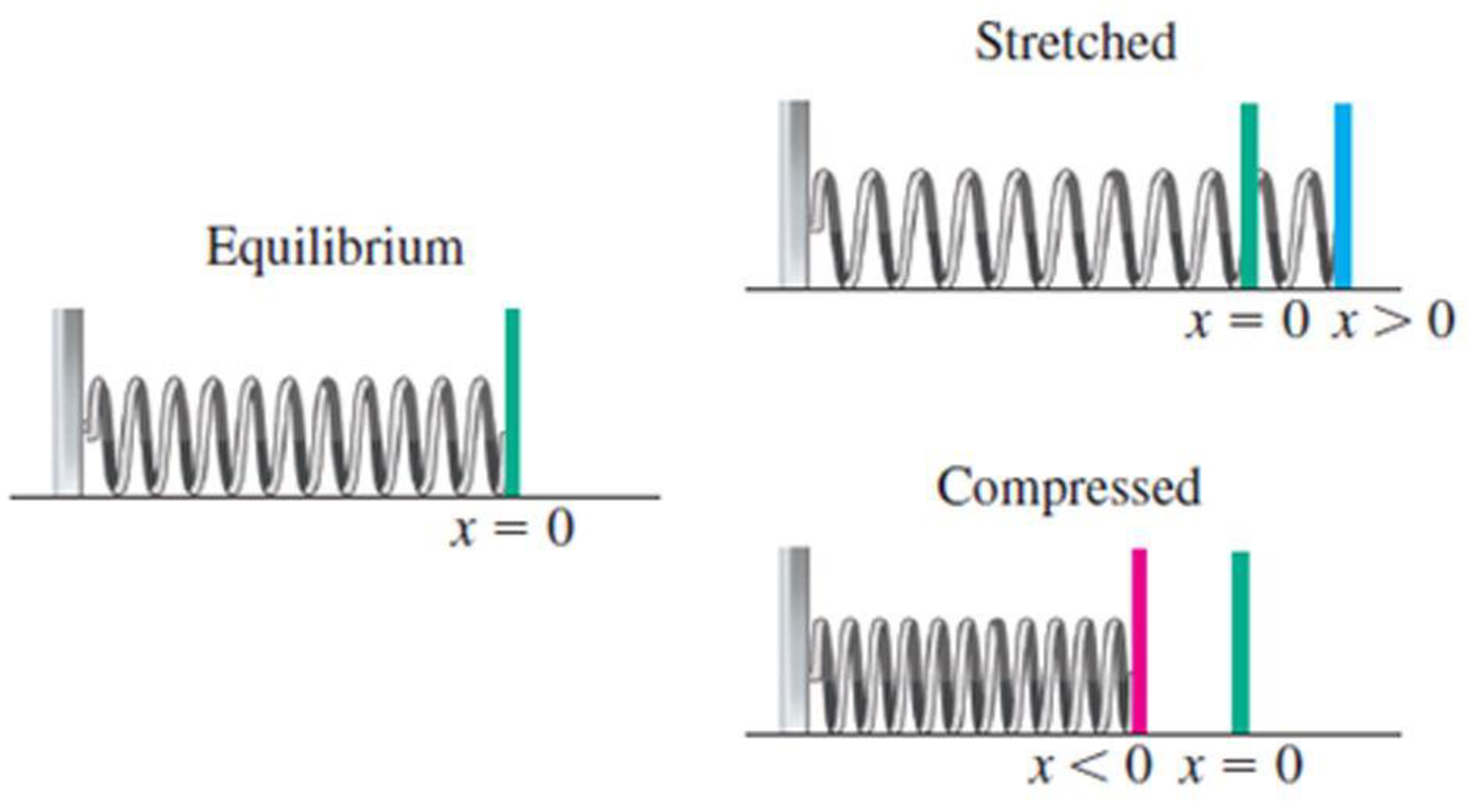
Applications
43–46. Horizontal oscillators The equation of motion for a spring-block system that lies on a horizontal surface (see figure) is the same as the equation of motion for a vertically suspended system. As before, m is the mass of the block, k is the spring constant, c is the damping coefficient (perhaps due to friction as the block slides on the surface), and Fext is an external force. We let x(t) be the position of the block at time t, where x increases to the right and x = 0 is the position of the block at which the spring is neither stretched nor compressed.

a. Find the position of the block in the following situations.
b. Graph the position function.
c. Describe the type of motion you observe.
45. m = 4 kg, c = 4 kg/s, k = 17 N/m,
Fext = 148 sin t, x(0) = 0, x′(0) = 0
Want to see the full answer?
Check out a sample textbook solution
Chapter D2 Solutions
CODE/CALC ET 3-HOLE
- Let X be a discrete random variable taking values in {0, 1, 2, . . . }with the probability generating function G(s) = E(sX). Prove thatVar(X) = G′′(1) + G′(1) − [G′(1)]2.[5 Marks](ii) Let X be a random variable taking values in [0,∞) with proba-bility density functionfX(u) = (5/4(1 − u^4, 0 ≤ u ≤ 1,0, otherwise. Let y =x^1/2 find the probability density function of Yarrow_forward2. y 1 Ο 2 3 4 -1 Graph of f x+ The graph gives one cycle of a periodic function f in the xy-plane. Which of the following describes the behavior of f on the interval 39 x < 41 ? (Α B The function f is decreasing. The function f is increasing. The function f is decreasing, then increasing. D The function f is increasing, then decreasing.arrow_forwardDepth (feet) 5- 4- 3- 2. WW www 1 D B 0 10 20 30 40 50 60 70 80 Time (hours) x A graph of the depth of water at a pier in the ocean is given, along with five labeled points A, B, C, D, and E in the xy-plane. For the time periods near these data points, a periodic relationship between depth of water, in feet, and time, in hours, can be modeled using one cycle of the periodic relationship. Based on the graph, which of the following is true? B C The time interval between points A and B gives the period. The time interval between points A and C gives the period. The time interval between points A and D gives the period. The time interval between points A and E gives the period.arrow_forward
- A certain type of machine produces a number of amps of electricity that follows a cyclic, periodically increasing and decreasing pattern. The machine produces a maximum of 7 amps at certain times and a minimum of 2 amps at other times. It takes about 5 minutes for one cycle from 7 amps to the next 7 amps to occur. Which of the following graphs models amps as a function of time, in minutes, for this machine? A B C D Amps M 3 4 5 678 Minutes Amps w 3 4 5 6 7 8 Minutes 8 Amps- 6+ Amps y 2345678 Minutes 456 8 Minutesarrow_forward5 4. ·3. -2+ 1+ AN -5 -3 -4- 1 x 3 ད Graph of f The graph of the function f is given in the xy- plane. Which of the following functions has the same period as f? A B ми warrow_forwarda C d 2 1 -1 0 1 2 3 -1 Graph of f'(x) (5) The graph of f'(x), the derivative of f(x), is shown in the figure above. The line tangent to the graph of f'(x) at x=0 is vertical and f'(x) is not differentiable at x = 1. Which of the following statements is true? (a) f'(x) does not exist at x = 0. (b) f(x) has a point of inflection at x = 1. (c) f(x) has a local maximum at x = 0. (d) f(x) has a local maximum at x = 1.arrow_forward
- Let C be the intersection of the cylinder x² + y² = 2.95 with the plane z = 1.13x, with the clockwise orientation, as viewed from above. Then the value of COS (₤2 yo 2 y dx -x dy+3zdz is 0.131 -0.108 -0.891 -0.663 -0.428 0.561 -0.332 -0.387arrow_forwarduse a graphing utility to sketch the graph of the function and then use the graph to help identify or approximate the domain and range of the function. f(x)= x*sqrt(9-(x^2))arrow_forwarduse a graphing utility to sketch the graph of the function and then use the graph to help identify or approximate the domain and range of the function. f(x)=xsqrt(9-(x^2))arrow_forward
- Calculate a (bxc) where a = i, b = j, and c = k.arrow_forwardi+2j+3k = (1,2,3) and b = -i-k. Calculate the cross product a x b where a Next calculate the area of the parallelogram spanned by a and b.arrow_forwardThe measured receptance data around two resonant picks of a structure are tabulated in the followings. Find the natural frequencies, damping ratios, and mode shapes of the structure. (30 points) (@)×10 m/N α₁₂ (@)×10 m/N w/2z (Hz) 99 0.1176 0.17531 0.1114 -0.1751i 101 -0.0302 0.2456i -0.0365 -0.2453i 103 -0.1216 0.1327i -0.1279-0.1324i 220 0.0353 0.0260i -0.0419+0.0259i 224 0.0210 0.0757i |-0.0273 +0.0756i 228 -0.0443 0.0474i 0.0382 +0.0474iarrow_forward
- Algebra & Trigonometry with Analytic GeometryAlgebraISBN:9781133382119Author:SwokowskiPublisher:Cengage
